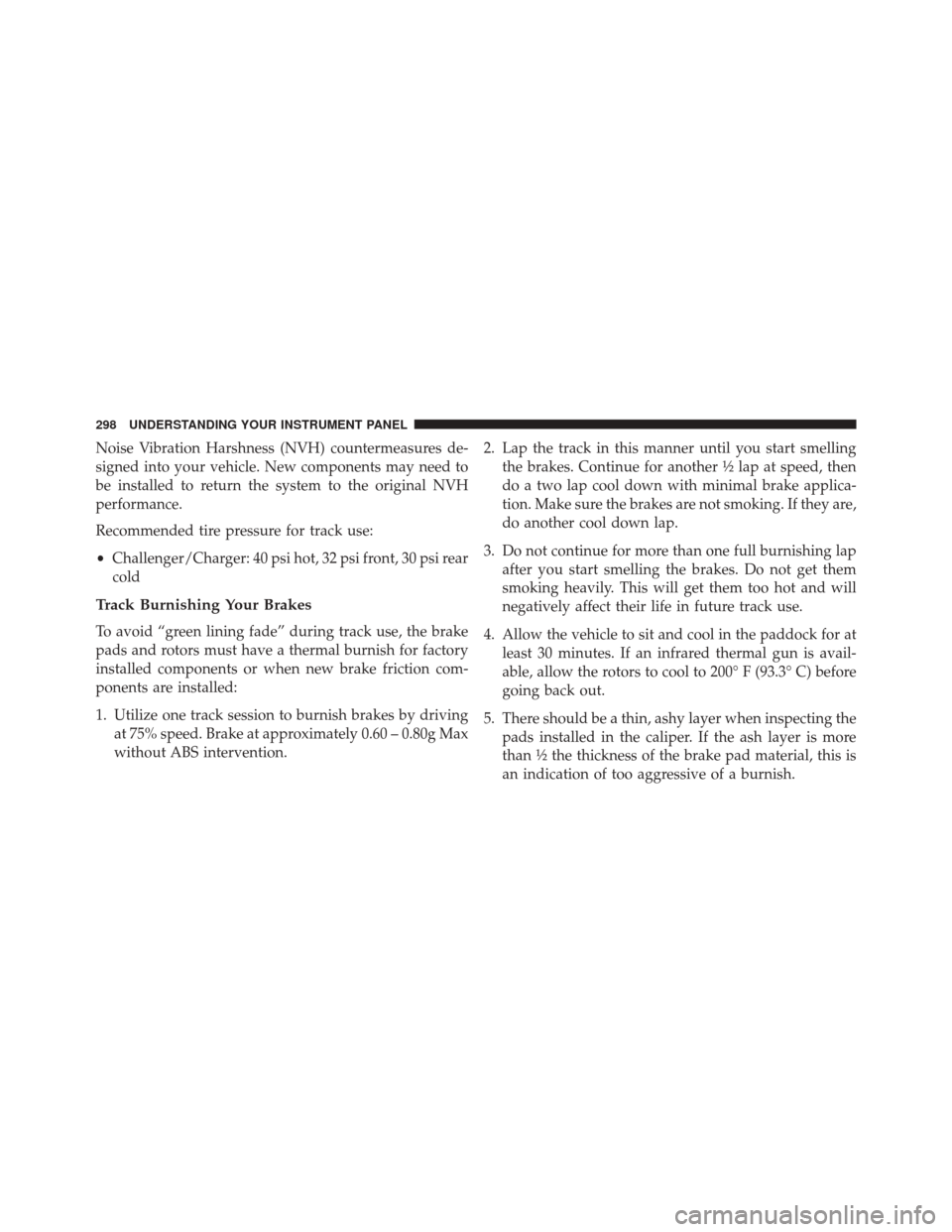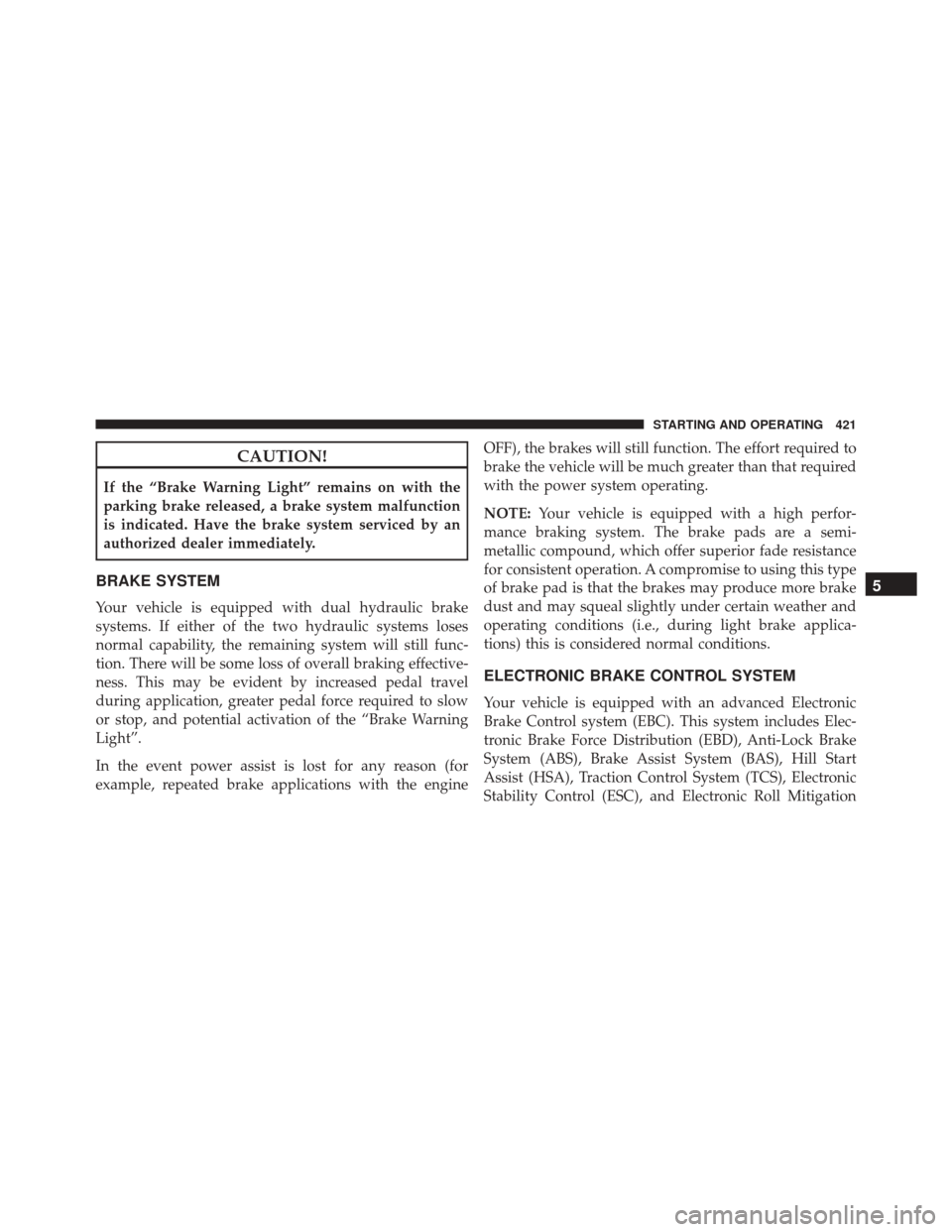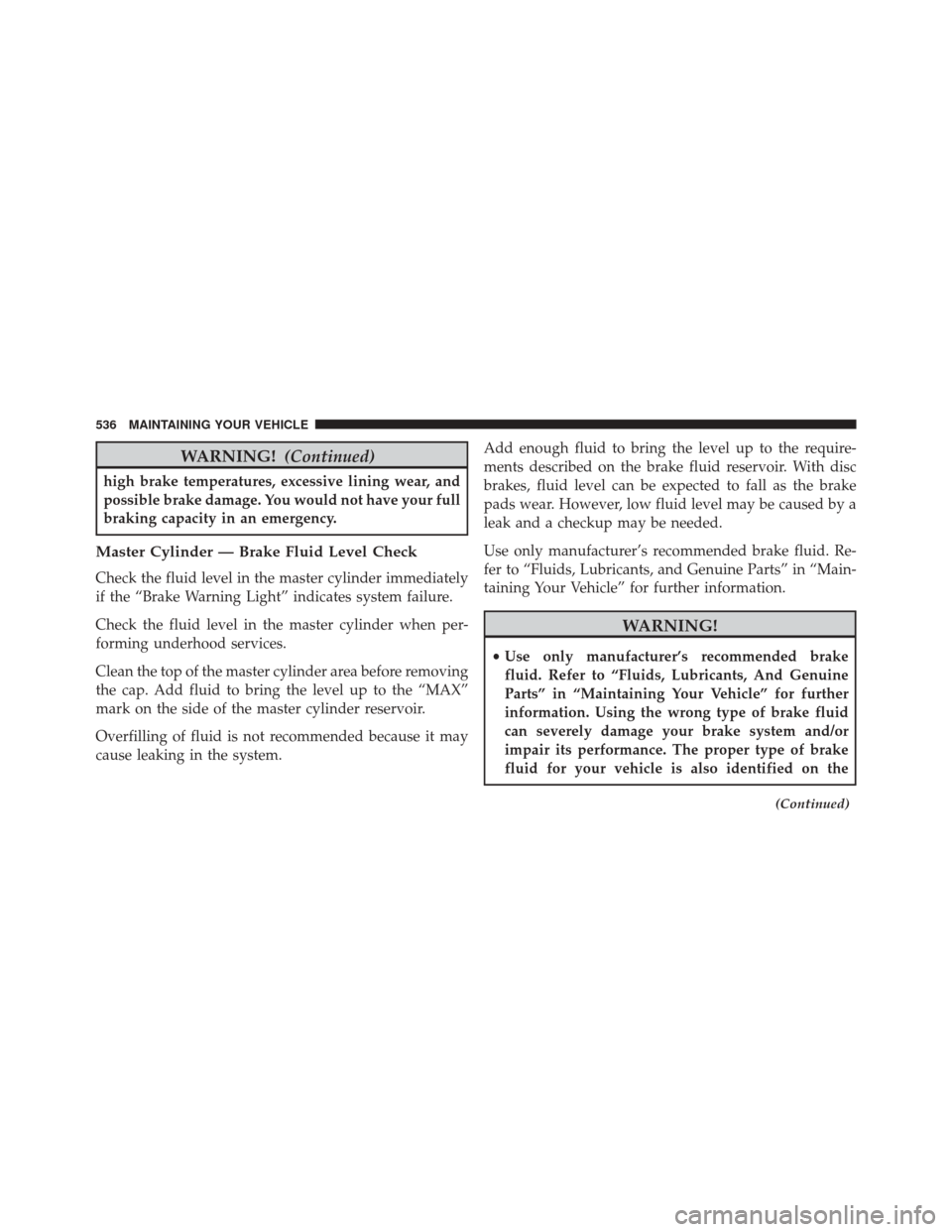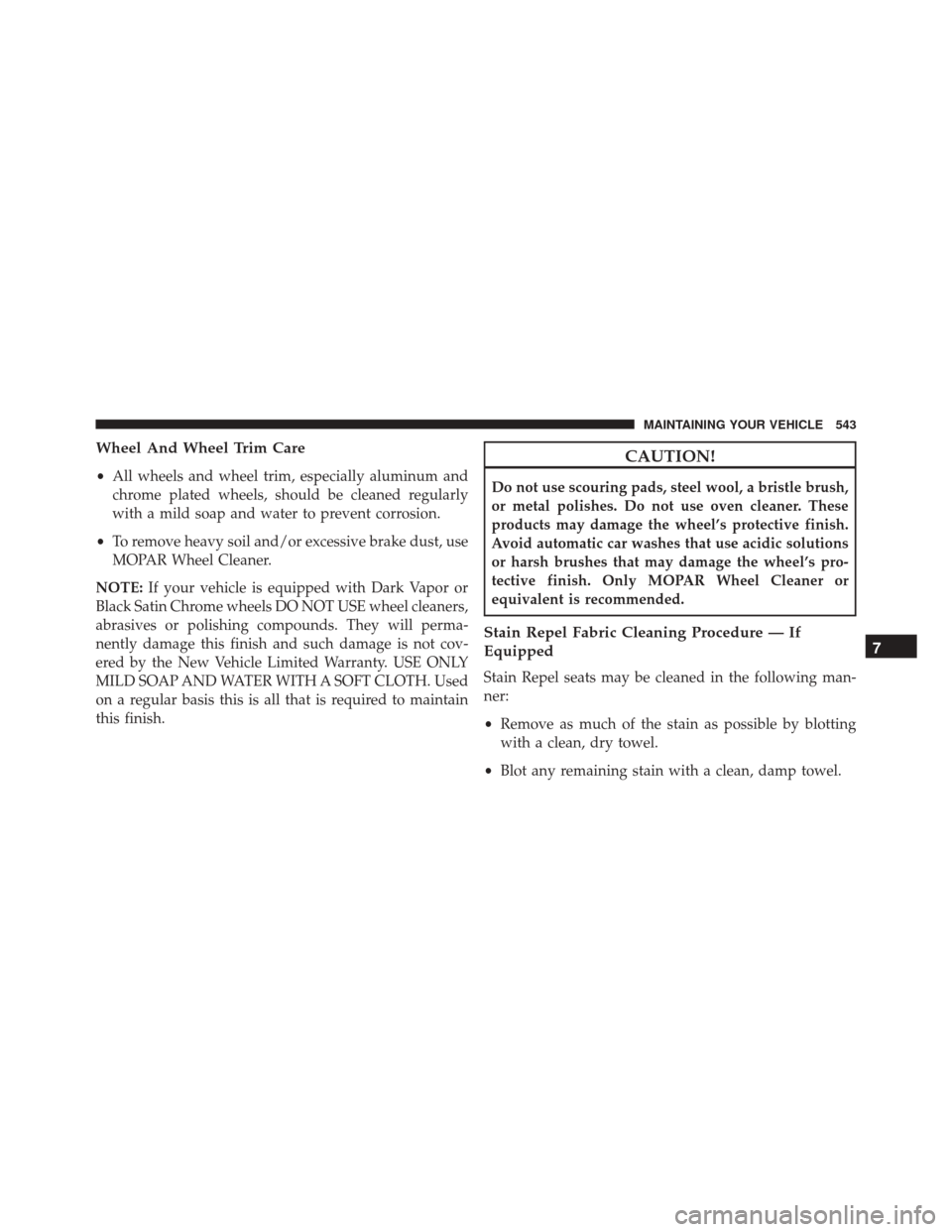2016 DODGE CHALLENGER SRT brake pads
[x] Cancel search: brake padsPage 299 of 616

situations. It is recommended that your vehicle operates
in SPORT or TRACK modes during the track event.
Prior to each track event/day:
•Verify allfluids are at the correct levels. Refer to
“Maintaining Your Vehicle” for fluid levels & specifi-
cations.
• Verify the front and rear brake pads have more than ½
the original pad thickness remaining. If the brake pads
require changing, please burnish prior to track outing
at full pace. Refer to “Track Burnishing Your Brakes.”
At the conclusion of each track event, it is recommended
that a brake bleed procedure be performed to maintain
the pedal feel and stopping capability of your Brembo
High Performance brake system.
It is recommended that each track outing end with a
minimum of one cool down lap using minimal braking. Change the differential and manual transmission fluid
after every five hours of track use. Refer to “Maintaining
Your Vehicle” for fluid levels & specifications.
If equipped with a removable lower front fascia grille, it
is recommended to remove it for track use during
warm/hot weather to improve cooling airflow to critical
powertrain and cooling system components.
All SRT vehicles are track tested for 24 hours of endur-
ance, however, it is recommended that the suspension
system, brake system, prop shaft, and half shaft boots
should be inspected for wear or damage after every track
event.
Track usage results in increased operating temperatures
of the engine, transmission, clutch, driveline and brake
system. This increased operating temperature may affect
4
UNDERSTANDING YOUR INSTRUMENT PANEL 297
Page 300 of 616

Noise Vibration Harshness (NVH) countermeasures de-
signed into your vehicle. New components may need to
be installed to return the system to the original NVH
performance.
Recommended tire pressure for track use:
•Challenger/Charger: 40 psi hot, 32 psi front, 30 psi rear
cold
Track Burnishing Your Brakes
To avoid “green lining fade” during track use, the brake
pads and rotors must have a thermal burnish for factory
installed components or when new brake friction com-
ponents are installed:
1. Utilize one track session to burnish brakes by driving at 75% speed. Brake at approximately 0.60 – 0.80g Max
without ABS intervention. 2. Lap the track in this manner until you start smelling
the brakes. Continue for another ½ lap at speed, then
do a two lap cool down with minimal brake applica-
tion. Make sure the brakes are not smoking. If they are,
do another cool down lap.
3. Do not continue for more than one full burnishing lap after you start smelling the brakes. Do not get them
smoking heavily. This will get them too hot and will
negatively affect their life in future track use.
4. Allow the vehicle to sit and cool in the paddock for at least 30 minutes. If an infrared thermal gun is avail-
able, allow the rotors to cool to 200° F (93.3° C) before
going back out.
5. There should be a thin, ashy layer when inspecting the pads installed in the caliper. If the ash layer is more
than ½ the thickness of the brake pad material, this is
an indication of too aggressive of a burnish.
298 UNDERSTANDING YOUR INSTRUMENT PANEL
Page 301 of 616

6. Sometimes, a second burnish session is required. If thebrake pads start smelling in the next track session,
reduce speed and braking deceleration to burnish
targets and follow steps 2 through 4.
7. New brake pads installed on old rotors still need to be burnished. New rotors installed with old pads should
be burnished at the track, or street driven for 300 city
miles, to develop an adequate lining transfer layer on
the rotor surface prior to track use.
8. Rotors that pulsate during track use should be re- placed. Resurfacing of the rotors is not recommended,
as it removes mass from the rotor, reducing its thermal
capacity. Resurfacing also thins the rotor cheek, mak-
ing it less robust and increasing the likelihood of
pulsation in further track use.SRT PERFORMANCE PAGES
Performance Pages is an application that provides a
display for performance indicators, as received from the
Instrument Cluster, that will help you gain familiarity
with the capabilities of your SRT vehicle in real-time.
To access the SRT Performance Pages, press the “Apps”
button on the touchscreen, then press the “SRT Perfor-
mance” button on the touchscreen, or press “SRT Pages”
in the top left of the touchscreen while in Drive Modes.
Press the desired button on the touchscreen to access that
specific Performance Page.
WARNING!
Measurement of vehicle statistics with the SRT Per-
formance Pages is intended for off-highway or off-
road use only and should not be done on any public
(Continued)
4
UNDERSTANDING YOUR INSTRUMENT PANEL 299
Page 412 of 616

•Prior to each track event, verify the front and rear
brake pads have more than ½ pad thickness remain-
ing. If the brake pads require changing, please burnish
prior to track outing at full pace.
• At the conclusion of each track event, it is recom-
mended that a brake bleed procedure is performed to
maintain the pedal feel and stopping capability of your
Brembo High Performance brake system.
• It is recommended that each track outing should end
with a minimum of 1 cool down lap using minimal
braking.
• If equipped with a removable lower front fascia grille,
it is recommended to remove it for track use during
warm/hot weather to improve cooling airflow to
critical powertrain and cooling system components. •
All SRT vehicles are track tested for 24 hours of
endurance. However, it is recommended that suspen-
sion system, brake system, prop shaft, and ½ shaft
boots should be checked for wear or damage after
every track event.
• Track usage results in increased operating tempera-
tures of the engine, transmission, clutch – if equipped,
driveline and brake system. This may affect noise
(NVH) countermeasures designed into your vehicle.
New components may need to be installed to return
the system to the original NVH performance.
• Tire pressure:
• 40psi (276kpa) hot, recommend 32psi (221kpa) front,
30psi (207 kpa) rear cold
410 STARTING AND OPERATING
Page 413 of 616

NOTE:It is recommended that you target 40psi (276kpa)
Hot Tire Pressure at the conclusion of each track session.
Starting at 32psi (221kpa) Front & 30psi (207 kpa) Rear
Cold and adjusting based on ambient & track conditions
is recommended. Tire pressure can be monitored via the
Driver Information Display (DID) and can assist with
adjustments.
Track burnishing your brakes:
To avoid “green lining fade” during track use, the brake
pads and rotors must have a thermal burnish for factory
installed components or when new brake friction com-
ponents are installed:
1. Use one track session to burnish brakes by driving at 75% speed. Brake at approximately 0.60-0.80g max
without ABS intervention.
2. Lap the track in this manner until you start smelling the brakes. Continue for another ½ lap at speed, then do a two lap cool down with minimal brake applies.
Make sure the brakes are not smoking. If they are, do
another cool down lap.
3. Do not continue for more than 1 full burnishing lap after you start smelling the brakes. Do not get them
smoking heavily. This will get them too hot and affect
their life negatively in future track use.
4. Allow vehicle to sit and cool in the paddock for at least 30 min. If an infrared thermal gun is available, allow
rotors to cool to 200°F (93.3°C) before going back out.
5. There should be a thin, ash layer when inspecting the pads installed in the caliper. Having the ash layer go
more than half the thickness of the pad material
indicates too aggressive of a burnish.
5
STARTING AND OPERATING 411
Page 423 of 616

CAUTION!
If the “Brake Warning Light” remains on with the
parking brake released, a brake system malfunction
is indicated. Have the brake system serviced by an
authorized dealer immediately.
BRAKE SYSTEM
Your vehicle is equipped with dual hydraulic brake
systems. If either of the two hydraulic systems loses
normal capability, the remaining system will still func-
tion. There will be some loss of overall braking effective-
ness. This may be evident by increased pedal travel
during application, greater pedal force required to slow
or stop, and potential activation of the “Brake Warning
Light”.
In the event power assist is lost for any reason (for
example, repeated brake applications with the engineOFF), the brakes will still function. The effort required to
brake the vehicle will be much greater than that required
with the power system operating.
NOTE:
Your vehicle is equipped with a high perfor-
mance braking system. The brake pads are a semi-
metallic compound, which offer superior fade resistance
for consistent operation. A compromise to using this type
of brake pad is that the brakes may produce more brake
dust and may squeal slightly under certain weather and
operating conditions (i.e., during light brake applica-
tions) this is considered normal conditions.
ELECTRONIC BRAKE CONTROL SYSTEM
Your vehicle is equipped with an advanced Electronic
Brake Control system (EBC). This system includes Elec-
tronic Brake Force Distribution (EBD), Anti-Lock Brake
System (ABS), Brake Assist System (BAS), Hill Start
Assist (HSA), Traction Control System (TCS), Electronic
Stability Control (ESC), and Electronic Roll Mitigation
5
STARTING AND OPERATING 421
Page 538 of 616

WARNING!(Continued)
high brake temperatures, excessive lining wear, and
possible brake damage. You would not have your full
braking capacity in an emergency.
Master Cylinder — Brake Fluid Level Check
Check the fluid level in the master cylinder immediately
if the “Brake Warning Light” indicates system failure.
Check the fluid level in the master cylinder when per-
forming underhood services.
Clean the top of the master cylinder area before removing
the cap. Add fluid to bring the level up to the “MAX”
mark on the side of the master cylinder reservoir.
Overfilling of fluid is not recommended because it may
cause leaking in the system. Add enough fluid to bring the level up to the require-
ments described on the brake fluid reservoir. With disc
brakes, fluid level can be expected to fall as the brake
pads wear. However, low fluid level may be caused by a
leak and a checkup may be needed.
Use only manufacturer’s recommended brake fluid. Re-
fer to “Fluids, Lubricants, and Genuine Parts” in “Main-
taining Your Vehicle” for further information.
WARNING!
•
Use only manufacturer’s recommended brake
fluid. Refer to “Fluids, Lubricants, And Genuine
Parts” in “Maintaining Your Vehicle” for further
information. Using the wrong type of brake fluid
can severely damage your brake system and/or
impair its performance. The proper type of brake
fluid for your vehicle is also identified on the
(Continued)
536 MAINTAINING YOUR VEHICLE
Page 545 of 616

Wheel And Wheel Trim Care
•All wheels and wheel trim, especially aluminum and
chrome plated wheels, should be cleaned regularly
with a mild soap and water to prevent corrosion.
• To remove heavy soil and/or excessive brake dust, use
MOPAR Wheel Cleaner.
NOTE: If your vehicle is equipped with Dark Vapor or
Black Satin Chrome wheels DO NOT USE wheel cleaners,
abrasives or polishing compounds. They will perma-
nently damage this finish and such damage is not cov-
ered by the New Vehicle Limited Warranty. USE ONLY
MILD SOAP AND WATER WITH A SOFT CLOTH. Used
on a regular basis this is all that is required to maintain
this finish.
CAUTION!
Do not use scouring pads, steel wool, a bristle brush,
or metal polishes. Do not use oven cleaner. These
products may damage the wheel’s protective finish.
Avoid automatic car washes that use acidic solutions
or harsh brushes that may damage the wheel’s pro-
tective finish. Only MOPAR Wheel Cleaner or
equivalent is recommended.
Stain Repel Fabric Cleaning Procedure — If
Equipped
Stain Repel seats may be cleaned in the following man-
ner:
• Remove as much of the stain as possible by blotting
with a clean, dry towel.
• Blot any remaining stain with a clean, damp towel.
7
MAINTAINING YOUR VEHICLE 543